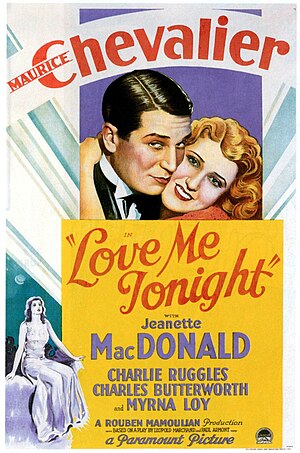Love Me Tonight
Jump to navigation
Jump to search
| Love Me Tonight | ||||||||||||||||||||||
|---|---|---|---|---|---|---|---|---|---|---|---|---|---|---|---|---|---|---|---|---|---|---|
This film has been preserved in the National Film Registry in 1990.
| ||||||||||||||||||||||
 | ||||||||||||||||||||||
|
Love Me Tonight is a 1932 American pre-Code musical comedy film produced and directed by Rouben Mamoulian, with music by Rodgers and Hart. It stars Maurice Chevalier as a tailor who poses as a nobleman and Jeanette MacDonald as a princess with whom he falls in love. It also stars Charles Ruggles as a penniless nobleman, along with Charles Butterworth and Myrna Loy as members of his family.
Why It Rocks
- When Hollywood was making the transition from silent to sound films, studios quickly exhausted the musicals genre on film with Ernst Lubitsch being perhaps the biggest example. One particular way this film stands out is that, after Mamoulian took the reigns for this film when Lubitsch stepped down, he used a technique he created called a "symphony of noises" which he'd used in a Broadway play, and duplicated here in the film’s opening, using rhythm to provide a sweeping view of Paris, from street cleaners and shop workers to philandering aristocrats. Although this had been done several times before, his other theories, such as the usage of shadows, were uncommon at the time.
- A complicated subplot from the original play is discarded in the film version
- The music numbers actually expand the story, advance the plot and add depth to its characters and aren't just filler. There’s also some rhymed dialogue moving the film closer to operettas
- Three of the songs, "Lover", "Mimi" and "Isn't It Romantic" would become standard.
- Some of them even snuck in some risqué innuendo for its time, such as “The Son of a Gun Is Nothing But a Tailor”
- With Rodgers writing an overture and transitional music, there were 114 separate orchestral segments in total. The songwriters' contributions provide much of the continuity for the story, especially since Mamoulian seemed more interested in his experiments than in the structure of the film. The opening scenes are brimming with directorial flourishes. Chevalier performs "Isn't It Romantic" in front of a three-way mirror, providing four different angles of the same shot, with lyrics for the song being carried to various singers, which eventually links to the female lead.
- Similarly, "Mimi" and "The Son of a Gun Is Nothing But a Tailor" also get traded lyrics among the cast with several different singers.
- Most of the film was realized on a more modern musical format that eschewed European antecedents.